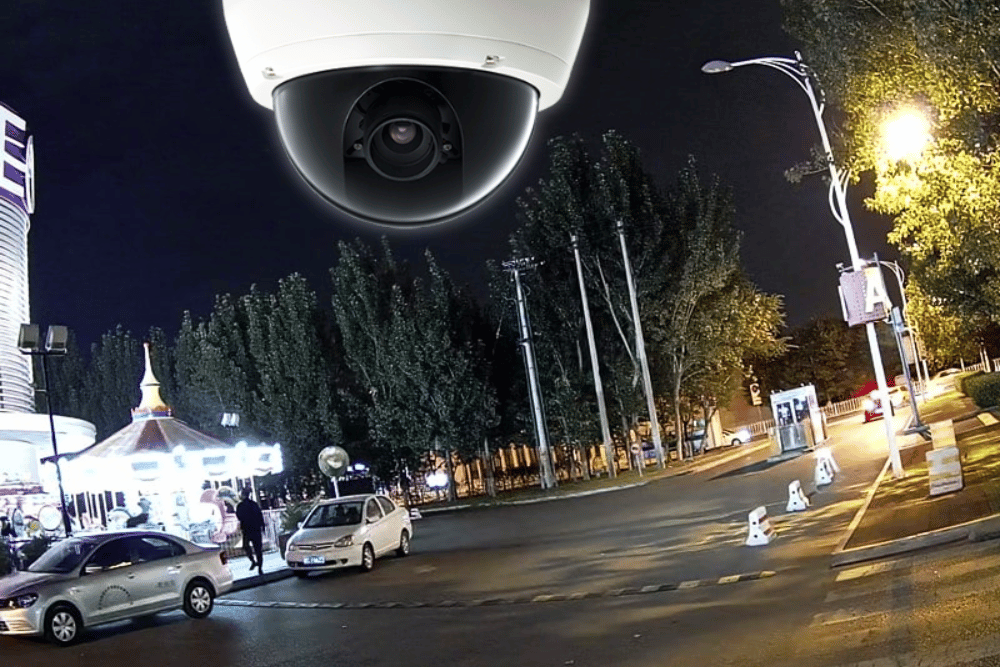Security Technology Trends: Night Vision With Color

It’s the dead of night, and a shadowy figure approaches your home or business. Your trusty old security cameras dutifully record with their black-and-white night vision mode. The details are fuzzy, the colors are washed out, and you’re left with a grainy mystery. Wouldn’t it be different if you could see that figure in night vision with color—to discern their clothing and potentially even their identity?
This isn’t some futuristic surveillance dream. Color night vision is here, and it’s a game-changer for the world of security. More property owners are investing in this technology, recognizing the advantage of clear, color-rich footage even in the darkest of nights.
In today’s world, where security concerns are paramount, the ability to identify threats accurately is more critical than ever. Traditional night vision technology, while fairly effective in low-light conditions, often presents challenges in distinguishing details due to its monochromatic output.
However, with the advent of color night vision cameras, this limitation is gone. A new level of clarity has arrived.
How Does Color Night Vision Work?
To comprehend the significance of color night vision, it’s helpful to understand the technology.
Traditional night vision cameras use infrared light to capture images in low light. However, color night vision cameras incorporate advanced imaging sensors and signal processing algorithms to render scenes in full color.
Inside these cameras are cutting-edge CMOS (complementary metal-oxide-semiconductor) sensors. These boast improved light sensitivity and enhanced signal-to-noise ratios. Combined with sophisticated image processing software, the sensors enable the camera to extract color information from the available ambient light, augmenting the visual fidelity of nighttime footage.
And there’s more:
- Ultra-Sensitive Sensors: These sensors capture every last glimmer of visible light. Even the faintest glow from a streetlamp, porch light, or stars helps.
- Large Aperture Lenses: A larger aperture means more light enters the camera, leading to brighter, clearer images.
- Supplemental Lighting: Some cameras integrate floodlights to add a powerful “color boost” to the scene. A motion-activated light can also signal to intruders that they’ve triggered a security system, serving as a preventive security measure in its own right.
The process begins when the camera’s sensor captures ambient light. This light, which may originate from sources like the moon, stars, or artificial illumination, contains a full spectrum of visible and invisible wavelengths. Next, the sensor converts this incoming light into electrical signals. The onboard algorithms process the signals to reconstruct the scene in color. By analyzing the intensity and distribution of light across different wavelengths, the camera can differentiate between colors and render them faithfully in the final image.
Traditional night vision typically produces green-tinted imagery due to the use of monochrome sensors and infrared light. By comparison, a full color night vision camera preserves the natural hues of the environment. This makes it much easier to identify who or what is on the scene.
The Importance of Night Vision with Color
Night vision in color isn’t just a cool technical innovation. It also translates to real-world benefits.
- Enhanced Detail: Colors help provide critical details about an event. Was that suspicious car red or blue? What color jacket was someone wearing? Color information significantly improves awareness and the ability to make accurate observations.
- Improved Identification: Facial features, logos, license plates—identifying factors get muddled in black-and-white night vision footage. Full color makes suspect identification easier.
- Deterrence: Some studies suggest that colored lighting (used by some color night vision systems) can psychologically deter would-be criminals.
- Operates in Ultra-Low Light Environments: These cameras are capable of functioning effectively even in 0 lux conditions, using minimal ambient light. Depending on how much daylight you usually enjoy in your hometown, that may be doubling the useful working hours of your surveillance system.
These cameras empower surveillance service providers to make more informed decisions when monitoring a home, business, or public space.
Consider the scenario of a guard watching over a dimly lit parking lot. With traditional technology, distinguishing between a harmless bystander and a potential intruder (or even a critter) might prove challenging. However, full-color nighttime footage allows the guard to pick out car colors, shirt logos, weapons, and other critical details that are necessary for swift and accurate threat assessment.
Moreover, enhanced situational awareness can lead to faster response times and improved incident management. Law enforcement agencies, for instance, can leverage this technology to track suspects more effectively, potentially reducing crime rates and enhancing public safety.
Applications Across Industries
Businesses aren’t the only ones seeing the light. Color night vision is popping up all over.
- Home Security: Protecting your family is invaluable. Color night vision helps provide better footage of activity happening around your home, boosting your peace of mind.
- Retail and Hospitality: From theft prevention to customer service, color night vision improves safety and assists staff with accurately logging incidents at shops, hotels, and restaurants.
- Warehousing and Industrial: Low-light environments don’t have to slow operations. Color night vision helps protect assets, monitor operations, and improve incident response.
- Law Enforcement and Public Safety: Capturing clearer, more detailed footage in low-light situations can play a critical role in investigations and public safety initiatives.
By harnessing advanced technology, these cameras enable users to perceive the world after dark in vibrant, true-to-life colors, enhancing situational awareness and facilitating more effective threat detection and response.
Choosing the Right Color Night Vision Camera
Not all color night vision cameras are made equal. Here are key factors to consider.
- Minimum Illumination: This measures the minimum amount of light (measured in lux) the camera needs to provide a color image. The lower the lux rating, the better the low-light performance.
- Aperture: Aim for a low f-stop number (like f/1.0) for maximum light collection.
- Resolution: Higher security camera resolution ensures sharp, detailed images.
- Supplemental Lighting: Does the camera use an integrated floodlight when needed?
- Network Options: Your two major choices are wireless security cameras or a PoE camera system. Wireless offers faster, more flexible installation, but PoE offers better network and power stability. Deep Sentinel offers full-color night vision for both types of cameras.
As the demand for robust security solutions continues to rise, color night vision cameras are poised to play a pivotal role in safeguarding communities, businesses, and critical infrastructure against emerging threats. By embracing this transformative technology, we can embark on a journey toward a safer, more secure future under the cover of night. Soon, the technology will be as commonplace as the classic black-and-white night vision we’ve had for a while now.
If you’re seeking increased situational awareness, easier identification, and a powerful addition to your video surveillance system, color night vision cameras—like those offered by Deep Sentinel—are the cutting-edge answer.
Need a Solution that Prevents Crime? Deep Sentinel is the only security technology that delivers the experience of a personal guard on every customer’s home and business. Call 833.983.6006 for your free security consultation.

